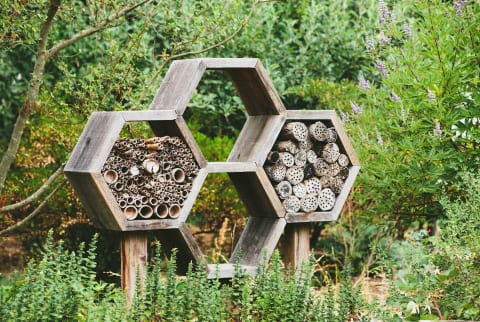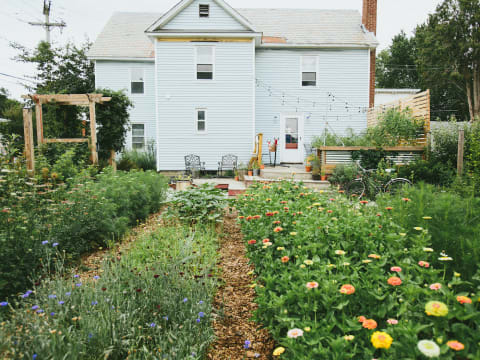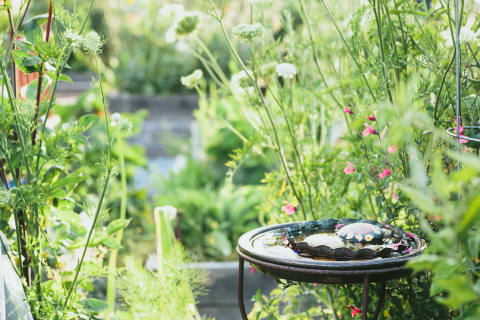Advertisement
Growing Habitat Starts At Home: 3 Ways To Rewild Your Garden & Support Biodiversity


Habitat fragmentation occurs when large expanses of land are broken into smaller, isolated parcels. Trees are cut, houses are built, cities expand, and industry and conventional farms replace wilderness. The thing is, habitats rely on connectivity.
When we carve up landscapes, we disenfranchise whole groups of plants and animals, cutting them off from the wonderfully complex systems upon which they rely. The climate crisis adds insult to injury, fueling the problem while shrinking habitable landscapes.
We can grow habitat and offset habitat fragmentation by planting with the purpose of supporting biodiversity in our home plots and cityscapes. When we take the bird's-eye view, we can look for thoughtful ways to connect these spaces into living greenways.
How to create living greenways and why they're important
The equation we're after is my garden + your garden + your neighbor's garden = save the planet one garden at a time. However, we can go one step further and, if you remember the order of operations from Algebra 1, the equation is more like this: (my garden + your garden + your neighbor's garden) (community green spaces + parks + greenways + wild places + beyond-organic farms) = save the planet one garden at a time.
Thoughtfully planted gardens are veritable lifelines for rewilding our home planet, reminding us that what is local is global.
A three-year survey conducted by the University of Bristol found that our urban and suburban landscapes are potential havens for biodiversity. Farm fields may be feast or famine for wildlife, but villages, towns, and cityscapes are filled with habitat—an abundant and diverse range of plants and flowers blooming through the seasons. Even our kitchen garden plots play a vital role. Here lies the power to save pollinators, insects, and ourselves.
The study made these key suggestions:
- Grow a garden and increase the number and size of community gardens.
- Mow less, shrink your lawn, and if you do have a lawn, mix turf with flowering plants.
- Encourage a diversity of plantings that bloom through the seasons.
- Grow fruits, vegetables, and companions (more on those below).
- Focus on plants preferred by pollinators such as natives and select ornamentals.
- Give certain weeds like dandelions room to grow.
Nature is the best at rewilding. We're merely doing what we can to keep up, help out, and mimic her ways, using techniques such as companion planting, interplanting, growing a food forest, creating edges and ecotones, and building homes for wildlife. These are nature-based solutions; simultaneously, they're a language—dialogue through action, if you will—for growing healthier humans and healthier habitats
Nature-based solutions to try in your home garden:
Interplanting
How might your plants best coexist, support biodiversity, and make the most of the square yards (or feet) you have on hand? Interplanting explores these questions with numerous points of entry.
Begin with a commonsense approach and work with plants' growth habits and maturation times to increase productivity and optimize space. To do this, grow taller plants such as sunflowers at the north end of beds, sun-loving crops to their south, and plants that require afternoon shade such as leafy greens and parsley to the north of both. It's also possible to grow successions of quick-growing crops like radishes, lettuces, and cilantro among plants with multimonth growing seasons such as Tuscan kale, chard, and tomatoes.

Another interplanting duo I rely on is the pairing of radishes and carrots. Sow them side by side. The radishes will be up and out long before the carrots are ready, and the quick-emerging radish sprouts will remind you where you planted your carrots (something I sometimes have trouble remembering, especially because carrots always seem to take an excruciatingly long time to germinate).
Native Americans historically interplanted a set of crops they called the three sisters. Have you heard of them? It's the combination of corn, beans, and squash, and the numerous legends of the three sisters revolve around their bond and relationship to one another.
To grow a three-sisters garden, simply sow beans around corn and plant squash at their feet. The corn is sturdy and rises tall, providing the support that pole beans need. Beans are soil builders, fixing nitrogen in the ground thanks to their relationship with rhizobia bacteria, which is helpful because corn tends to be a heavy feeder. And squash covers ground, helping prevent weed growth, retain soil moisture, and moderate soil temperatures. You'll sometimes see sunflowers in the place of corn, and historically, some Native American peoples are also known to have added Rocky Mountain bee plant (Cleome serrulata) to the mix to encourage pollination.
Use interplanting techniques in flower gardens, perennial borders, and larger landscapes to achieve many of the same goals as in food gardens: cover ground, optimize space, and let the plants do much of the work of caring for soil while creating habitat for wildlife.
Edges and ecotones
It turns out that the edges of ecosystems are biodiversity-rich hubs. Have you ever stepped out of a forest into a meadow to find an unbelievable number of birds and insects darting about, skipping from grass to flower? Or perhaps you've noticed the shift in animal and plant life when approaching a stream or lake? The complex intersection of conditions at the edges of ecological niches is ripe for life.
In nature, the transition from one biological community to another is an ecotone—a word born from the two words ecology and -tone, derived from the Greek tonos, meaning tension. Ecotones form when distinct communities blend gradually or abruptly. An edge is exactly what you might expect, the place or line where two different systems come together. What happens at the edges of systems is sometimes referred to as the edge effect.
You can easily create edges and ecotones in your garden and the landscapes closest to home. Add a water feature or mow a path through a meadow. Or add a perennial border around your food or flower garden, particularly one filled with native plants, and you're on your way to a biodiversity-rich ecotone grown at home.

Homes for wildlife
It was in one of my first gardens that I startled a toad from its home. We both jumped when I moved a rock aside—her from her hiding spot and me to my feet. I clearly remember the awe that washed over me, followed by an immediate sense of regret. How did I miss the signs that the hollowed-out opening under the rock was the entry to a toad home? Yet, honestly, a toad was the last creature I expected to find living in that high mountain desert garden. It was only after she disappeared that I connected the dots and saw her residence for what it was: shady, cool, protected, and damp, with plenty of insects to eat—the perfect toad home.
Not that long ago, I discovered tiny native bees living in the hollowed-out stems of last year's raspberry canes. Just like the time I unknowingly routed the toad from its home, this was a moment when I was forced to pause and wonder, Who else lives here? And who else can I invite?
To figure this out, quietly observe your plot and survey who might be coming and going. Next, it helps to step inside the world of nature for perspective. If you were a bee, where would you live? What is your perfect home? It's also helpful to learn more about the animals native to your region so you can begin with intention. The homes you create are a direct function of who might inhabit them.
Adapted from an excerpt of Grow Now: How We Can Save Our Health, Communities, and Planet―One Garden at a Time by Emily Murphy with permission from the publisher.
Watch Next
Enjoy some of our favorite clips from classes
Enjoy some of our favorite clips from classes
What Is Meditation?
Mindfulness/Spirituality | Light Watkins
Box Breathing
Mindfulness/Spirituality | Gwen Dittmar
What Breathwork Can Address
Mindfulness/Spirituality | Gwen Dittmar
The 8 Limbs of Yoga - What is Asana?
Yoga | Caley Alyssa
Two Standing Postures to Open Up Tight Hips
Yoga | Caley Alyssa
How Plants Can Optimize Athletic Performance
Nutrition | Rich Roll
What to Eat Before a Workout
Nutrition | Rich Roll
How Ayurveda Helps Us Navigate Modern Life
Nutrition | Sahara Rose
Messages About Love & Relationships
Love & Relationships | Esther Perel
Love Languages
Love & Relationships | Esther Perel


















